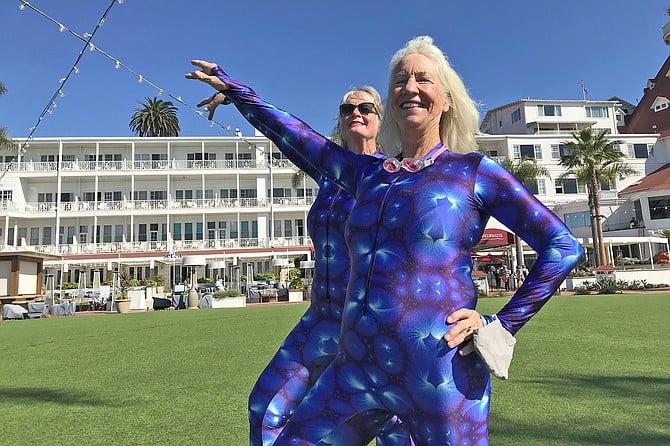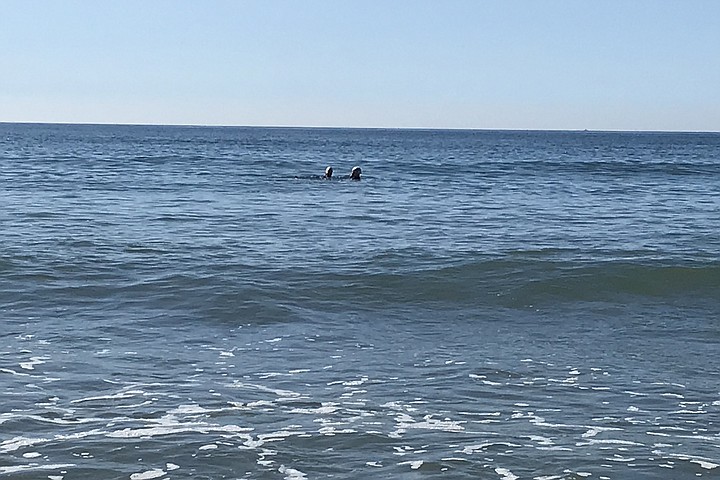 Facebook
Facebook
 X
X
 Instagram
Instagram
 TikTok
TikTok
 Youtube
Youtube

Just up from the shipwreck, the Shark Bait Mamas are counting down to the music they use to, uh, swim to. Dani Grady leans over and switches on a recorder. “1, 2, 3, 4, 5, 6, 7, and eight!” she calls to her followers. Okay, there’s just her buddy Nancy Blair this morning. “But wait until Sunday,” says Nancy. “There’ll be eight of us.”
The two go into what looks like a vaudeville routine in their electric blue swimming costumes. Kinds of shimmy shimmy, arm swinging, finger-pointing, eggbeaters, pinwheel moves.
“It’s easy here on land,” says Dani, “but you try this in the waves, out of your depth.”
“We dance in the ocean,” says Nancy.
We’re not talking spring chickens here, either. They’re both in their early sixties.
“You’re going in the water today?” I ask, because it’s shivery cold, even here on the Hotel Del’s lawn.
“Absolutely,” says Dani. “We’re rehearsing our moves.”

But why? “We just got sick of swimming laps,” says Dani.
These gals are swimmers, but they’ll do anything for kicks. Like back in 2009, they decided they were going to relay-swim the English Channel.
“It’s 32 miles of rough water, cold as all get-out,” says Dani. “We swim one hour each, it takes 13 hours, and it’s hard.”
“You have to start off at night,” says Nancy.
“All you can see as you take your breath is the boat-driver’s light if you look left, or utter black nothingness if you look right.”
But what about the infamously busy shipping traffic in the narrow neck of the Channel? “Ships have to stop for us, whether they’re ferries or supertankers. Channel swims. It’s the law.” Large ships don’t stop so easily, I’m thinking, but I don’t tell them that.
But this synchronized swimming I’ve got to see. They say it goes back to Germany before 1900. But it was movie stars such as Esther Williams who made it a craze with such movies as Bathing Beauty in 1944.
But why “Shark Bait Mamas”? “Have you heard about the young Great Whites hanging out here?” says Dani. “It’s not like La Jolla. Water’s 10 degrees warmer up there, and the ocean floor is alive with sea creatures. Especially leopard sharks and porpoises. Great Whites like it here. Cooler.”
They get a lot of older people wanting to try synchronized (or artistic) swimming, maybe because of the news that having cold water around your brain helps it fight off dementia.
“But synchronized swimming ain’t for the faint-hearted,” Dani says. “It takes muscle-power, lung-power because you’re underwater so much, and enough control to coordinate with others, when you know there’s nothing under your feet, for up to an hour.”
Two minutes later, these two sixty-somethings have their caps on, their nostril blockers in, and their countdown started as they walk resolutely into the cold waters of November. Five more minutes, and they’re out beyond the surf line, swimming a coordinated freestyle that’s beautiful in a zen way. Then they’re on their backs, or upside-down, one leg stuck straight up in the air, then the other. Then they dive, disappear, and start again. They kind of frolic in disciplined procession 50 yards out from where Age of Russia lies in the shallows.
“What’s that?” says a kid pointing at the splashes. “Birds? Sharks? Porpoises?”
“Kind of,” I say.


Just up from the shipwreck, the Shark Bait Mamas are counting down to the music they use to, uh, swim to. Dani Grady leans over and switches on a recorder. “1, 2, 3, 4, 5, 6, 7, and eight!” she calls to her followers. Okay, there’s just her buddy Nancy Blair this morning. “But wait until Sunday,” says Nancy. “There’ll be eight of us.”
The two go into what looks like a vaudeville routine in their electric blue swimming costumes. Kinds of shimmy shimmy, arm swinging, finger-pointing, eggbeaters, pinwheel moves.
“It’s easy here on land,” says Dani, “but you try this in the waves, out of your depth.”
“We dance in the ocean,” says Nancy.
We’re not talking spring chickens here, either. They’re both in their early sixties.
“You’re going in the water today?” I ask, because it’s shivery cold, even here on the Hotel Del’s lawn.
“Absolutely,” says Dani. “We’re rehearsing our moves.”

But why? “We just got sick of swimming laps,” says Dani.
These gals are swimmers, but they’ll do anything for kicks. Like back in 2009, they decided they were going to relay-swim the English Channel.
“It’s 32 miles of rough water, cold as all get-out,” says Dani. “We swim one hour each, it takes 13 hours, and it’s hard.”
“You have to start off at night,” says Nancy.
“All you can see as you take your breath is the boat-driver’s light if you look left, or utter black nothingness if you look right.”
But what about the infamously busy shipping traffic in the narrow neck of the Channel? “Ships have to stop for us, whether they’re ferries or supertankers. Channel swims. It’s the law.” Large ships don’t stop so easily, I’m thinking, but I don’t tell them that.
But this synchronized swimming I’ve got to see. They say it goes back to Germany before 1900. But it was movie stars such as Esther Williams who made it a craze with such movies as Bathing Beauty in 1944.
But why “Shark Bait Mamas”? “Have you heard about the young Great Whites hanging out here?” says Dani. “It’s not like La Jolla. Water’s 10 degrees warmer up there, and the ocean floor is alive with sea creatures. Especially leopard sharks and porpoises. Great Whites like it here. Cooler.”
They get a lot of older people wanting to try synchronized (or artistic) swimming, maybe because of the news that having cold water around your brain helps it fight off dementia.
“But synchronized swimming ain’t for the faint-hearted,” Dani says. “It takes muscle-power, lung-power because you’re underwater so much, and enough control to coordinate with others, when you know there’s nothing under your feet, for up to an hour.”
Two minutes later, these two sixty-somethings have their caps on, their nostril blockers in, and their countdown started as they walk resolutely into the cold waters of November. Five more minutes, and they’re out beyond the surf line, swimming a coordinated freestyle that’s beautiful in a zen way. Then they’re on their backs, or upside-down, one leg stuck straight up in the air, then the other. Then they dive, disappear, and start again. They kind of frolic in disciplined procession 50 yards out from where Age of Russia lies in the shallows.
“What’s that?” says a kid pointing at the splashes. “Birds? Sharks? Porpoises?”
“Kind of,” I say.
Comments